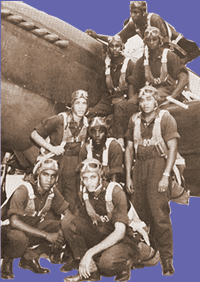|
Who were the Tuskegee Airmen?
During World War II
, the United
States Military, like so much of the nation, was segregated. Jim Crow Laws
kept blacks from entering public places such as libraries, restaurants, and
movie theaters. Although African Americans served in the armed forces, they
were restricted in the types of jobs and positions they could hold. On
April 3, 1939, Public Law 18 was passed which provided for an expansion of
the Army Air Corps. One section of the law offered hope for those African
Americans who wanted to advance their military careers beyond the kitchen
or the motor pool. It called for the creation of training programs to be
located at black colleges which would prepare blacks for service in a
variety of areas in the Air Corps support services.
The program
for training an all black flying unit took place at the Tuskegee Institute
in Tuskegee, Alabama. The Institute, founded by Booker T. Washington in
1881, had a strong Civilian Pilot Training Program (CPTP) under the
direction of Charles Alfred Anderson, the nation's first African American
to earn a pilot's license. The Army chose Tuskegee as the training grounds
for the new segregated 99th Pursuit Squadron in January 1941 and the
"Tuskegee Airmen" took flight.
From 1941 to
1946 over 2000 African Americans completed training at Tuskegee and nearly
three quarters of them qualified as pilots while the remainder were trained
as navigators or support personnel. The 99th Pursuit Squadron was activated
and became the 99th Fighter Squadron in May 1942. The Tuskegee Airmen saw
combat in over 1500 missions in Europe and North Africa. Not one of the
bombers that the Tuskegee Airmen escorted was lost to enemy fire; the 99th
Fighter Squadron is the only U.S. squadron to hold that distinction during
the Second World War.
Although the
Tuskegee Airmen played an integral part in the outcome of World War II,
their most important victory was the one at home. Due to the bravery,
tenacity, and success of the Tuskegee Airmen, President Harry S. Truman
desegregated the United States Military in 1948.
Eleanor Roosevelt lends her support
First Lady
Eleanor Roosevelt was very interested in the work at the Tuskegee
Institute, particularly in the aeronautical school. In 1941 she visited
Tuskegee Army Air Field and asked to take a flight with one of the Tuskegee
pilots. Although the Secret Service was anxious about the ride, flight
instructor Charles A. Anderson piloted Mrs. Roosevelt over the skies of
Alabama for over an hour. That flight proved for Mrs. Roosevelt that blacks
could fly airplanes and she did everything in her power to help them in
that endeavor. Mrs. Roosevelt marked the occasion with a photograph of
herself and Mr. Anderson which she promptly brought back to her husband,
the President of the United States, and successfully urged FDR to utilize
the 99th Squadron in combat missions.
 Continuing her support of Tuskegee and the airmen,
Eleanor Roosevelt corresponded with both faculty and airmen. One person
that she had a lengthy correspondence with was Cecil Peterson. Cecil
Peterson was in the Army's Tuskegee training program and was chosen at
random as a correspondent for Mrs. Roosevelt. Ironically, Mrs. Roosevelt
had met Peterson years before while visiting a New Deal project in Quoddy,
Maine
(see photo on right)
. They continued their letters throughout the war, and Mrs.
Roosevelt was even able to meet Cecil Peterson again on her trip to visit
the troops overseas. Continuing her support of Tuskegee and the airmen,
Eleanor Roosevelt corresponded with both faculty and airmen. One person
that she had a lengthy correspondence with was Cecil Peterson. Cecil
Peterson was in the Army's Tuskegee training program and was chosen at
random as a correspondent for Mrs. Roosevelt. Ironically, Mrs. Roosevelt
had met Peterson years before while visiting a New Deal project in Quoddy,
Maine
(see photo on right)
. They continued their letters throughout the war, and Mrs.
Roosevelt was even able to meet Cecil Peterson again on her trip to visit
the troops overseas.
Eleanor
Roosevelt also corresponded with F.D. Patterson, the president of the
Tuskegee Institute, and lent her support to the Institute whenever she was
able to do so.
|




